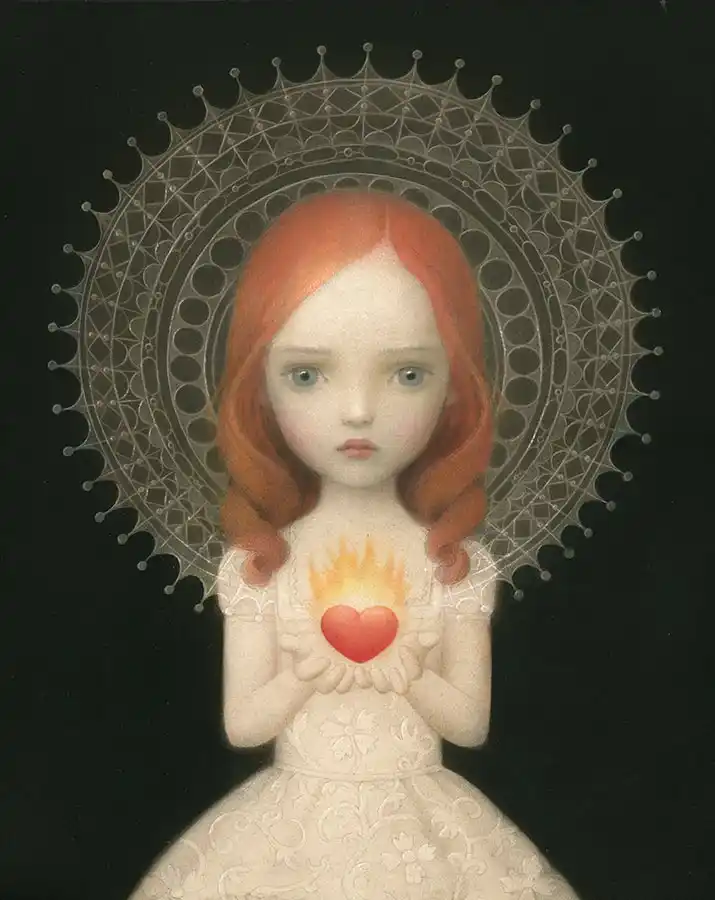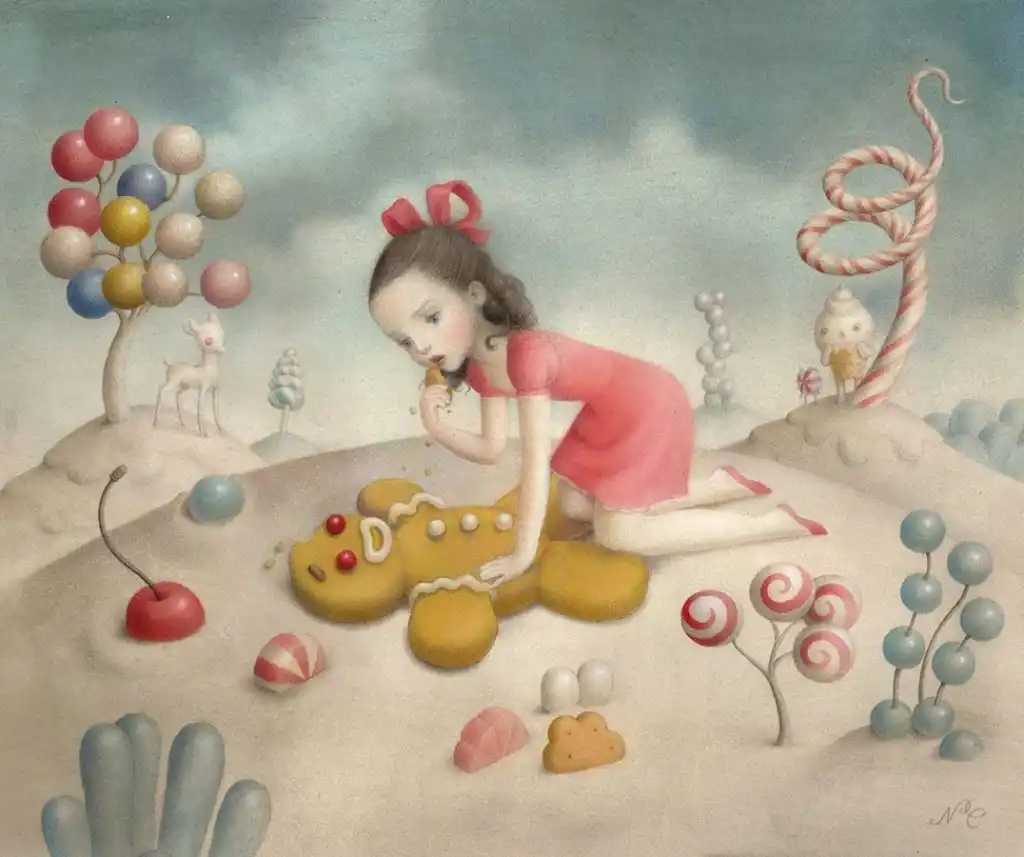Free shipping on all US orders
10% OF OUR PROFIT GOES TO KIDS’N’CULTURE NON-PROFIT ORGANIZATION
Since I was a child, my mother, an elementary school teacher, always surrounded me with beautiful illustrated books and encouraged me to follow my dreams. My father, instead, was the creative force in the family, a highly inventive carpenter. I grew up in his workshop, filled with wood and tools, which I used to craft toys with my own hands.
The restlessness that emanates from my art began in my adolescence: the fear of growing up, the difficulties in relating to others, the struggle with self-acceptance, and the feeling of loneliness. I attempted to ease my anxieties by immersing myself in sugary worlds, which only led to a perpetual sense of never being fully satisfied, always craving more.
I allude to a conflicted relationship with food, a form of addiction, or suppression of appetites driven by a need for affection rather than sugar. The compulsion to control my world, and the fear of succumbing to someone else’s authority are recurring themes still today in my art.




I aim to create artworks that are ‘beautiful’, yet conceal more beneath the surface. I seek to evoke contrasting emotions and suggest that beauty and happiness often coexist with sadness and even ugliness. Recurring themes in my work include both emotional and affectionate dependencies, the obsession for control, and the pursuit of autonomy.
I often challenge stereotypes in my pieces, with the seemingly vulnerable subjects triumphing (like Little Red Riding Hood outsmarting the wolf). These are my desires coming to life or nightmares I exorcise through my art.
Seduction is another prevalent theme. The girls may take on the role of seductresses or find themselves ensnared by malevolent entities. I depict the longing to possess the beloved, juxtaposed with the fear of surrendering control. Love and death are pervasive forces coexisting in some of my art, occasionally entwining pleasure and pain in a fateful dance.
The settings I favor for these narratives often resemble diverse versions of wonderlands. I aim for my work to evoke both amusement and a touch of macabre, featuring a juxtaposition of the adorable and the violent.

I integrate vibrant and captivating elements like toys and candies, as I believe they strike a harmonious balance with the weightier, darker themes that lie beneath the surface of my works.
Frequently, a sense of impending danger looms in the backdrop of my creations.
My girl witches inhabit worlds that appear to exist at the dawn of creation, where magical and transcendent revelations unfold.
Organic and inorganic, animal and plant, natural and artificial seamlessly merge and intertwine. Metamorphosis is another recurrent theme.
My works serve as a reflection of my inner self, exposing my vulnerabilities, and at times, expressing the determination and strength I aspire to possess. Art is my vehicle to seek power, creativity, and spirituality.
The girls within my art embody a fusion of witches, saints, and wielders of otherworldly powers. My young heroines endeavor to overcome their monsters and assert their independence, even in the face of approaching princes.
Yet, at times, the price of this independence is solitude.
I grew up with the ‘good girl’ complex, always striving to be perfect, trying to be the best in class. Girls are often expected to be pretty, kind, and obedient. The ‘good girl’ role compels us to conform, often at the cost of sacrificing important parts of ourselves.
We live in fear of judgment – the fear of not being enough, the fear of making mistakes, the fear of rejection. I conceived my artwork as a rebellion against the rigid model of perfection that society imposes on girls. We all have rough edges and shadows; we aren’t always flawless. It’s crucial to confront our darker sides to come to terms with them.
My dark fictions exude a certain feminine charm, even when the scenes depict violence or conflicts. Everything is presented with a seductively glossy surface and a touch of sweetness. I strive to achieve a delectable blend of the repulsive and the alluring in my images, which simultaneously exude beauty and menace, a touch of madness. This is me – a sweet but sometimes fierce, imperfect, and rebellious childlike person. I’ve learned to embrace it.

In recent years, I have been paying more attention to the choice of titles because they can add a contradictory or ironic note to the image, becoming an important part of the drawing. The title comes later. I am often undecided about several possible titles; each drawing is like a little birth because it is often the result of many reconsiderations, corrections to the colors or composition that change the meaning of the drawing. Sometimes, during the process, I find myself no longer convinced of an idea. That’s why I try to prepare sketches long before I start coloring them, so I have time to evaluate them better and understand if they are good ideas or not. Then, I sometimes discuss with friends to see how they react to an idea, to understand if something resonates with others, it helps me better assess what I am trying to communicate.



I’ve experienced many different types of commissions as an illustrator, making it hard to choose one that was more challenging than the others. Each one was unique and brought forth new challenges. I’ve always been appreciated for the sweetness of my female subjects – children and girls – and that’s what I was often asked for. That’s why I’ve especially enjoyed opportunities where no human figures were involved, like in the case of these wine labels. It allowed me to focus solely on creating a world of fantastical creatures, a blend of plant and animal.
One project that initially posed a challenge was a series of 12 still life paintings, focusing solely on fruits. It was a challenge to create recognizable works that still felt ‘mine’ even without including human figures, which are typically the core of my pieces.

Even though I have grown quite a bit since I started this job, I don’t feel that much different. Some insecurities that I expressed in my early drawings still accompany me… I still feel very childlike and vulnerable in many aspects of my personality, even though the years of childhood are now distant.
My dream is to continue putting every effort I can into my work. Every artwork I create is the result of a struggle and a challenge. When I feel I have achieved something good, it gives me one of the greatest satisfactions I can imagine. It rewards me for all the failures and frustrations I’ve been through. I hope to continue to draw and create for my own pleasure, beside people’s reactions to my art. I am already very thankful to be where I am
There are no reviews yet. Be the first one to write one.
A whole world on the tip of a pencil. The story of an artist who proved that true art has no limits and that it is never too late to start all over again.
International fashion icon and symbol of Parisian style, Ines de la Fressange is one of the most famous women in France.
Anastasia Pilepchuk is a Berlin-based artist with Buryat roots. She creates masks and face jewellery inspired by the nature and the culture of her beautiful region.
A whole world on the tip of a pencil. The story of an artist who proved that true art has no limits and that it is never too late to start all over again.